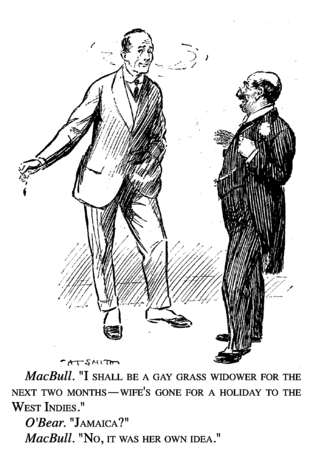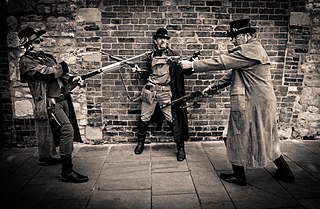
A metaphor is a figure of speech that, for rhetorical effect, directly refers to one thing by mentioning another. It may provide clarity or identify hidden similarities between two different ideas.

A pun, also rarely known as paronomasia, is a form of word play that exploits multiple meanings of a term, or of similar-sounding words, for an intended humorous or rhetorical effect. These ambiguities can arise from the intentional use of homophonic, homographic, metonymic, or figurative language. A pun differs from a malapropism in that a malapropism is an incorrect variation on a correct expression, while a pun involves expressions with multiple interpretations. Puns may be regarded as in-jokes or idiomatic constructions, especially as their usage and meaning are usually specific to a particular language or its culture.

Metonymy is a figure of speech in which a concept is referred to by the name of something closely associated with that thing or concept.

A figure of speech or rhetorical figure is a word or phrase that intentionally deviates from ordinary language use to produce a rhetorical effect. Figures of speech are traditionally classified into schemes, which vary the ordinary sequence of words, and tropes, where words carry a meaning other than what they ordinarily signify.

Synecdoche is a type of metonymy; it is a figure of speech in which a term for a part of something is used to refer to the whole, or vice versa. The term is derived from Ancient Greek συνεκδοχή (sunekdokhḗ) 'simultaneous understanding'.
Catachresis, originally meaning a semantic misuse or error—e.g., using "militate" for "mitigate", "chronic" for "severe", "travesty" for "tragedy", "anachronism" for "anomaly", "alibi" for "excuse", etc.—is also the name given to many different types of figures of speech in which a word or phrase is being applied in a way that significantly departs from conventional usage.

In rhetoric, chiasmus or, less commonly, chiasm, is a "reversal of grammatical structures in successive phrases or clauses – but no repetition of words".
Literal and figurative language is a distinction within some fields of language analysis, in particular stylistics, rhetoric, and semantics.
In rhetoric, litotes, also known classically as antenantiosis or moderatour, is a figure of speech and form of verbal irony in which understatement is used to emphasize a point by stating a negative to further affirm a positive, often incorporating double negatives for effect. Litotes is a form of understatement, which can be in the form of meiosis, and is always deliberate with the intention of emphasis. However, the interpretation of negation may depend on context, including cultural context. In speech, litotes may also depend on intonation and emphasis; for example, the phrase "not bad" can be intonated differently so as to mean either "mediocre" or "excellent". Along the same lines, litotes can be used, to euphemistically provide emphasis by diminishing the harshness of an observation; "He isn't the cleanest person I know" could be used as a means of indicating that someone is a messy person.

In rhetoric, a rhetorical device, persuasive device, or stylistic device is a technique that an author or speaker uses to convey to the listener or reader a meaning with the goal of persuading them towards considering a topic from a perspective, using language designed to encourage or provoke an emotional display of a given perspective or action. They seek to make a position or argument more compelling than it would otherwise be.
In rhetoric, zeugma and syllepsis are figures of speech in which a single phrase or word joins different parts of a sentence.
In literature and writing, stylistically elements are the use of any of a variety of techniques to give an auxiliary meaning, ideas, or feeling to the literalism or written.
In rhetoric, antanaclasis is the literary trope in which a single word or phrase is repeated, but in two different senses. Antanaclasis is a common type of pun, and like other kinds of pun, it is often found in slogans.
Signifyin' (sometimes written "signifyin(g)") is a practice in African-American culture involving a verbal strategy of indirection that exploits the gap between the denotative and figurative meanings of words. A simple example would be insulting someone to show them affection. Other names for signifyin' include: "Dropping lugs, joaning, sounding, capping, snapping, dissing, busting, bagging, janking, ranking, toasting, woofing, roasting, putting on, or cracking."

Owing to its origin in ancient Greece and Rome, English rhetorical theory frequently employs Greek and Latin words as terms of art. This page explains commonly used rhetorical terms in alphabetical order. The brief definitions here are intended to serve as a quick reference rather than an in-depth discussion. For more information, click the terms.

This glossary of literary terms is a list of definitions of terms and concepts used in the discussion, classification, analysis, and criticism of all types of literature, such as poetry, novels, and picture books, as well as of grammar, syntax, and language techniques. For a more complete glossary of terms relating to poetry in particular, see Glossary of poetry terms.
This is a glossary of poetry terms.
Trope denotes figurative and metaphorical language and one which has been used in various technical senses. The term trope derives from the Greek τρόπος (tropos), "a turn, a change", related to the root of the verb τρέπειν (trepein), "to turn, to direct, to alter, to change"; this means that the term is used metaphorically to denote, among other things, metaphorical language.

Irony, in its broadest sense, is the juxtaposition of what on the surface appears to be the case and what is actually the case or to be expected. It typically figures as a rhetorical device and literary technique. In some philosophical contexts, however, it takes on a larger significance as an entire way of life.

In cinema, a trope is what The Art Direction Handbook for Film defines as "a universally identified image imbued with several layers of contextual meaning creating a new visual metaphor".









